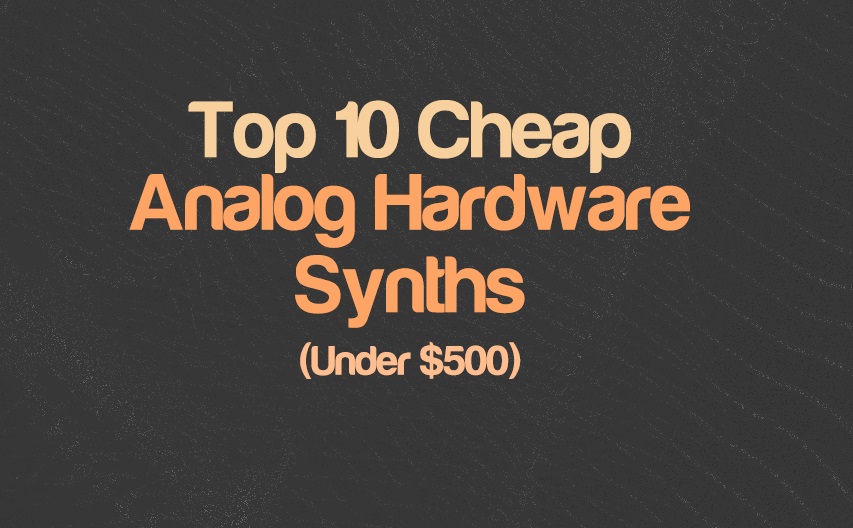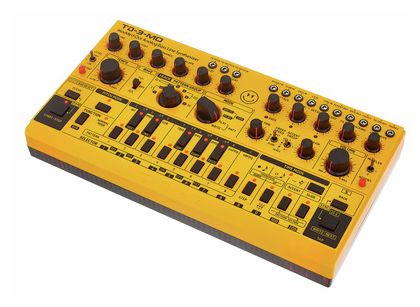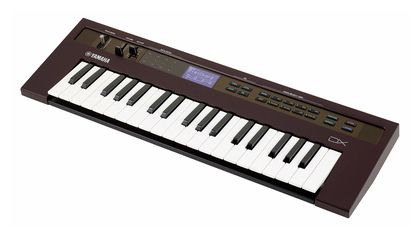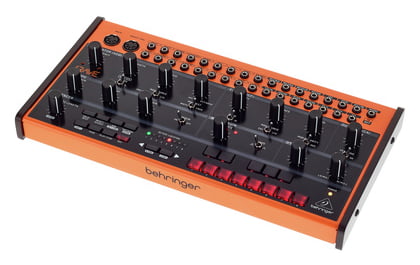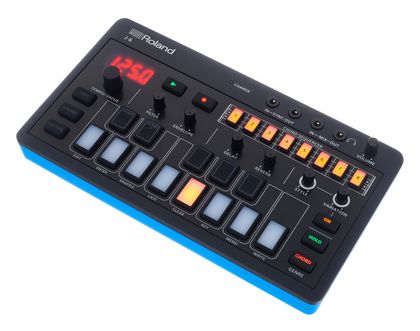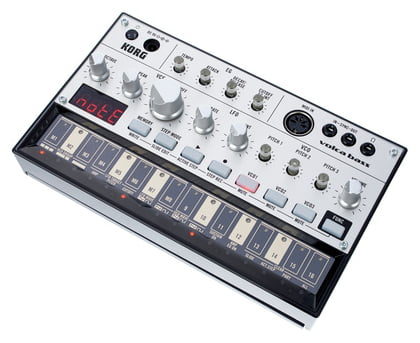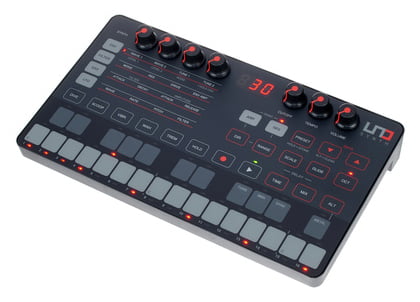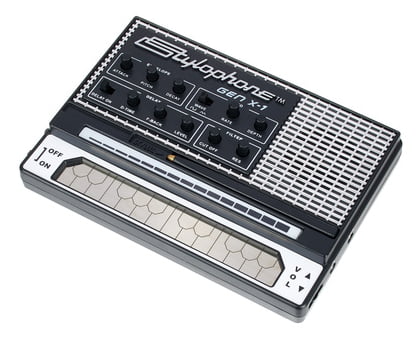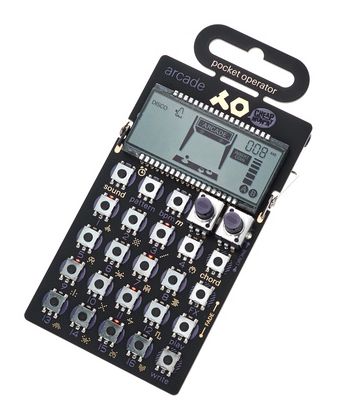For today’s installment, we will look at the top 10 analog hardware synths for under $500 in 2024.
With that said, here is our list:
2. Yamaha Reface DX FM Synthesizer
4. Roland Aira Compact J-6 Chord Synthesizer
5. Korg VOLCABASS Analog Synth
9. Modal Craft Synth 2.0 Portable
Teenage Engineering PO-20 arcade
The majority of analog-based synthesizers use a type of synthesis called subtractive synthesis to create their range of tones.
In short, subtractive synthesis involves removing frequencies from a complex waveform to adjust the overall timbre of the synthesizer. To quote Roland, “Think of the process of subtractive synthesis as being like a sculptor.”.
Several core parts make up any subtractive synthesizer:
- You have the voltage-controlled oscillator, which provides the base waveform that comprises the sound.
- A voltage-controlled filter that removes frequencies to sculpt the tone and a resonance control that accents or dulls the cutoff point by boosting for cutting it.
- A voltage-controlled amplifier that controls the amplitude of the wave.
- An envelope generator that allows you to sculpt the attack, decay, sustain, and release of the waveform,
- A low-frequency oscillator for modulating properties of the waveform to create exciting effects.
Besides the common subtractive synthesis, you also have additive, FM, and wavetable synthesis. Additive synthesis, in a nutshell, is the opposite of subtractive synthesis. You create various tones and timbres from scratch by adding sine waves at various frequencies and amplitudes on top of each other.
FM synthesis uses one or more oscillators—called modulators—to modulate a primary oscillator—called a carrier. The result is a substantially more complex waveform with a distinctive quality.
And lastly, you have wavetable synthesis, which uses a stored table of sampled one-shot waveforms. The table of sampled audio is cycled through on playback to create an ever-evolving concoction of sound.
10 Best Cheap Analog Hardware Synths 2024
1. Behringer TD-3-MO
Behringer has taken to releasing their rendition of a modified TB-303, called the Devil Fish—created by Robin Whittle of Real World Interfaces. It features many of the same modifications made to the TB-303, along with a couple of extra features that add to the grittiness that made the mods great.
The TD-3-MO is a monophonic, analog bassline synthesizer. It offers a heft of new features over the TD-3 that allows more envelope control through additional attack and decay dials, musical expression with the sequencer through their slide and accent controls, a thicker tone through a sub-oscillator, and a variety of CV, gate, and filter inputs and outputs.
Key Features:
- Single VCO
The VCO has a three-way switch for switching between two waveforms and an off position. You can use either a biting sawtooth or a hollow square wave to form the basis of your bass lines. Also, you can add a sub-oscillator with a 3-pole switch for the level that plays one octave below a sequence.
- 4-Pole Low Pass Filter with Keyboard Tracking
The low pass filter attenuates frequencies above the cutoff point by 24 dB per octave and has a comprehensive range, extending as low as closing the sound off completely to roughly 5 kHz for squealing runs. Moreover, the filter does track the keyboard, so the filter’s cutoff shifts depending on the note, which gives bass lines a slightly more natural characteristic.
- 16-Step Sequencer
The sequencer has an adjustable step range that reaches a maximum of 16 steps in a sequence. You can set the timing for each step to either a sixteenth note, to tie sixteenth notes, or for a sixteenth note rest. In addition, you will be able to add accents and slides to the individual notes in your loops.
- Track & Pattern Modes
Similar to the TD-3, the MO has four selectable pattern banks with individual A and B banks; overall, you can store up to 16 patterns on the device. Once you have your selection of patterns, you can create a sequence of patterns changed together in track mode.Seven tracks are available, each corresponding to a particular pattern bank.
Character & Sound:
By default, the tones are smooth and deep, but because of the filter’s extensive range, you can create highly sharp/squelching tones. If you need to add an extra level of grit to the signal, the overdrive effect offers a warmer, saturated tone to the mix without becoming overly distorted. And outside of the filter, you can use a muffler function to tame harmonics.
Pros:
They feature great control for creating musical passages. Steps in a sequence can be accented for a more dynamic sounding pattern. Moreover, the decay for accented and normal steps have separate dials, so that you can create a fluid distinction between the two.
Unlike the TD-3, you will have access to a filter FM input with dedicated control for adjusting the amount of frequency modulation for the filter.
Cons:
The manual provided lacks in-depth explanations for the controls. It gets the job done if you just want to know what the various controls are. But, if you want to know what the controls do, you may find the explanations underwhelming.
Summary:
The TD-3-MO can emulate the sounds of the 303 with very strenuous tweaking, but because of the extensive alterations and additions, they are, by nature, a different beast. The overall unruly grit and aggressiveness add a new flavor to a somewhat familiar face.
2. Yamaha Reface DX FM Synthesizer
The Reface DX is part of Yamaha’s series of portable mini-keyboards, each uniquely different from the next. It offers FM synth nostalgia with a hint of modern tone in a rather compact and slim case.
Yamaha’s Reface DX is a polyphonic, analog FM synthesizer with a user-friendly interface for operator tweaking. Like the rest of the Reface series, it has built-in speakers, can run off six AA batteries, supports USB and MIDI connectivity, and uses a 37-note mini keyboard.
Key Features:
- Four Adjustable Oscillators
Since the DX uses FM synthesis to create its range of sounds, you will have access to four oscillators that can each be set to act as either a carrier or a modulator. You will have access to up to twelve combinations for sculpting your FM tones.
- Four Adjustable Envelope Generators
Each operator has a dedicated ADSR envelope generator. For each EG, you can adjust each envelope stage’s level and length.
- Feedback
By default, the operators output a sine wave, but you can use feedback control to morph an operator’s waveform to form either a sawtooth, a square wave, or a combination of the standard sine wave and either of the two additional waves to create your interesting waveforms.
- Built-In Effects
The Reface DC has seven built-in effects for you to use. You will have access to distortion, touch wah, chorus, flanger, phaser, delay, and reverb. In addition, each effect has two parameters for adjusting the qualities of the effect.
- Phrase Looper
You will be able to record and playback passages with the phrase looper. It can record up to 2000 notes or 10 minutes at a BPM of 120. In addition, you can overdub phrases to create multi-layered loops, transpose loops, and edit patches seamlessly.
Character & Sound:
Yamaha’s Reface DX supports up to 8-notes polyphonically and has a mono mode. The sounds vary from pads, brass, bells, and percussion to bass, electric piano, and synthetic lead tones.
The sounds can be smooth and groove well, or they can be loud and in your face. Overall, the Reface DX offers a wide variety of tone options.
Pros:
The interface for modifying sounds is very user-friendly and easy to use, which makes sculpting your sounds easier than with other FM synthesizers.
In addition, with built-in speakers, a headphone jack, and the ability to operate off battery power for up to five hours, you can use them on the go comfortably.
Cons:
Unfortunately, any loops created are lost once the synthesizer is turned off, and there are no ways to save them, so if you come up with chart-topping loops, you will need to record them. Adding to the woes, some may find the mini-keys uncomfortable.
However, the keys are slightly longer than the standard. And lastly, since the polyphony only supports up to 8 notes, some may find the voicings limited.
Summary:
Yamaha’s Reface DX is a powerful, portable synth that makes FM synthesis more enjoyable and less painful. They are a welcome addition to anyone’s rig, especially if you are new to FM synthesis.
3. Behringer Crave
The Behringer CRAVE has been designed to emulate the sounds of synths from an era of iconic synthesizers. They use a ladder filter based on Moog’s 24dB ladder filter. And they sonically pay homage to Sequential’s influential Prophet-5.
Behringer’s CRAVE is a semi-modular monophonic synth. Despite being monophonic, they can be chained to additional Crave units for up to 16-Voice polyphony.
In terms of features, you will have a single VCO, a VCF, an LFO, and an EG at your fingertips. To top it all off, you will have plenty of patching options since they have up to 18 inputs and 14 outputs.
Key Features:
- Voltage Controlled Oscillator (VCO)
A single oscillator is available for creating tones. The Voltage Controlled Oscillator can be set to either a pulse wave or a reverse-sawtooth wave. You can adjust the pulse width to create a square wave when the pulse wave is selected. In addition, the tone can be adjusted up or down one octave.
- Voltage Controlled Filter (VCF)
You can use the Voltage Controlled Filter to create your desired tone by using a high-pass or low-pass filter that attenuates frequencies by 24db/octave. The low-pass filter removes frequencies above the cutoff frequency, creating a darker/lower tone. The high-pass filter removes frequencies below the set cutoff frequency, creating a thinner/higher tone.
- Modulation
A controllable Low-Frequency Oscillator allows you to modulate the main tone of the synth and the filter used to shape the wave. The LFO section only allows control over the LFO’s oscillation rate and the waveform shape used. The two waveforms offered are a Square wave and a Triangle wave.
- Envelope Generator
The envelope is used to control three of the four waveform sections. You will be able to adjust the attack, which is the initial start of the tone up to its loudest point, and the decay, which is the time the tone takes to lower from its loudest point to a consistent volume and sustain, which is the consistent volume until fading to silence. The decay control also adjusts the release of the tone.
Character & Sound:
Despite the limited VCO, VCF, and EG, the tones available are diverse and can fit many areas. You can create deep bass lines, velvety synth tones, chaotic or face-melting leads, percussive smacks, and mystifying pads.
Pros:
Behringer’s CRAVE offers exceptional versatility in a single package, especially if you can make the most of its available features. The oscillator can create a various deep to piercing tones with its flexible filtering options.
Cons:
As for downsides, the manual included can be difficult to decipher. If you struggle, you can leaf through the Mother-32 manual since the two synths operate similarly.
Like a few synths on this list, they do not offer a ¼” Jack output connection, so you will need an adapter for when you want to send the output to any outboard gear.
Suummary:
The CRAVE is a great choice if you are looking for a cheaper alternative to Moog’s Mother-32! Otherwise, if you’re looking for an analog synth that offers a lot of tones and sculpting for a low price, then this one is for you.
4. Roland Aira Compact J-6 Chord Synthesizer
The Roland AIRA Compact J-6 is a synth sequencer designed to help you effortlessly create loop-able chord progressions to simplify your songwriting process. In addition, they offer a range of features to help you get the creative juices flowing and get the most out of your creativity.
Roland’s AIRA Compact J-6 is built for playing chord sequences. You will have access to sound banks, a fantastic chord library, playful and fun styling options to create dynamic progressions, and various patterns to get you started.
Key Features:
- Preset Soundbanks
You will have access to eight different sound banks, each filled with eight different sounds, making up sixty-four preset sounds to start your J-6 journey. In addition, each sound is based on the iconic JUNO-60’s voicings.
- Preset Chord Library
You will have a hundred sets of chords at your fingertips with up to twelve chords per set. Each set is comprised of chords for a specific genre. The genres range from jazz, RnB, and blues to house, trance, and synth-wave.
Roland has even included chords for cinematic songs. Overall, there are roughly seventeen different genres and various genres to choose from. Once a genre has been selected, chords are programmed to play with the press of a single key. You won’t need to know chord shapes to create lavish sounds.
- Chord Style
Alongside easily playing chords based on genre, you can adjust the style used to play the chord. By adjusting the style, you can add flair to the chords played. There are up to nine different styling options and twelve variations for the first five styles. The style options include arpeggio variations, rhythmical timing options, and simple and rhythmic chord strumming.
- Filter & Effects
The Juno-6 is rather barebones for filtering and effects offered. The lack of complete control over the sound shows they have been built more for musicians and less for sound designers.
You will have access to a simple low-pass filter to control the brightness of the chords, a resonance control for accenting the filter’s cutoff point, and an envelope control to adjust attack and decay/release time. The synth uses two dials and a shift button to access these four features.
Character & Sound:
You will be able to conjure up a healthy variety of tones. As mentioned above, the sound banks available are similar to what you would find with the Juno-60, so you can expect some quintessential 80s analog synth tones.
The sounds range from low and smooth triangle waves to biting and harmonically rich sawtooth wave tones.
Pros:
The chord library and styling options are great for simplifying and sprucing up the chord progression creation process or just stepping out of the box you may usually place yourself in when creating music.
Cons:
Some may find the sound design and sound bank options limiting, in which case it would be better to look for something that offers more of a DIY approach to sculpting sounds.
Summary:
The AIRA Compact J-6 is highly recommended if you want a chord sequencer to accompany your song arrangements. Also, they can be great tools for any musician looking for a simple aid for the songwriting process.
5. Korg VOLCABASS Analog Synth
KORG offer a monstrously sounding bass synth with their VOLCABASS. Despite the limited filtering features, these small yet mighty synths groove and jive with the best of them and offer variety while doing so.
The Korg VOLCABASS features three groupable Voltage Controlled Oscillators, a simple Low-Frequency Oscillator, an exquisite Voltage Controlled Filter, and an AD Envelope Generator.
Key Features:
- 3 Voltage Controlled Oscillators
The Voltage Controlled Oscillators can be set to play either a sawtooth or a square wave. The VCOs can be played in three separate groupings. The first grouping allows you to individually control the tone and create a unique sequence for each oscillator.
The second grouping option merges VCO one and two, so you can create a thicker tone by merging the two waves. The third grouping combines all three VCOs into one large tone. On top of controlling the grouping structure, you can alter the pitch of each oscillator-up or down-by up to one octave.
- 1 Voltage Controlled Filter
A single low-pass filter controls the brightness of the overall tone. Opening the filter creates an airy and expansive sound, while closing creates a smoother tone. The VCF’s resonance control allows you to emphasize the cutoff frequency to create crisp peaks at moderate settings and gritty distortion at high settings.
- 1 Octave Keyboard
The keyboard can play up to one octave of notes, including three extra notes. The notes start at A and end at C, an octave higher. The black keys of the Volca Bass Synth are synonymous with the white keys on a chromatic keyboard and the gold-tinted keys with the black keys. You can adjust the keyboard’s octave using a dial above the LED screen. The octave settings span a six-octave range.
- 16-Step Sequencer
The keyboard also acts as a sequencer when either of the two-step recording modes is activated. You can record a sequence in real-time, or you can choose to input each step of the sequence manually.
Depending on the VCO grouping chosen, you will be able to record a sequence for each oscillator which means you can potentially have up to three individual sequences, each with its own tone.
- AD Envelope Generator
The envelope of the sound can be controlled using the built-in envelope generator. You will have control of the initial attack of the note, i.e., the time it takes for the note to reach its peak, and the decay and release, i.e., the time it takes for the note to fade out after releasing the key.
If you wish to forego fiddling with the envelope of the sound, you can opt to turn the envelope generator off, which will switch the envelope to a standard keyboard ADSR. In addition to controlling the sound’s envelope, the EG can be set to adjust the AD of the filter to create sweeping filtered tones.
Character & Sound:
The VOLCABASS’ tone is extremely versatile and packs a punch despite its small size. When using a single oscillator, the sawtooth wave produces a deep buzz and the square wave a thinner string-like buzz.
Depending on the combination of VCO groupings, varied pitches, waveforms, and filtering, you will be able to produce a variety of tones ranging from deep pulsating growls to high-pitched R2-D2 run-for-your-life screeches. In addition, the envelope generator will allow you to alter the length of these tones to create short staccato ticks to swelling atmospheric pads.
Also, you will be able to connect a MIDI IN cable to the synth to provide further control over the audio source.
Pros:
The sound offered is excellent and can compete with larger bass synths at higher price points, making them a great alternative if you are looking for a more affordable bass synthesizer.
Cons:
Unfortunately, you can’t automate the filters with the step sequencer, so you won’t be able to record filtering onto the sequence you are building.
And the only audio out connection is a 3.5mm stereo jack—which doubles as a headphone connection—so you will need to use a 3.5mm to 1/4″ Jack adapter should you wish to connect to an interface or mixer for playback through a PA system or for recording through DAW.
Summary:
Korg’s Volcabass is highly recommended for any synth user looking for something small and powerful yet gentle on the wallet. They compliment drum sequences superbly and offer enough filtering, effects, and character to fit a variety of sonic situations.
6. IK Multimedia UNO Synth
IK Multimedia has created a David-sized synth with Goliath-sized potential with the UNO Synth. The bite-sized device offers plenty of functionality for a synth within its price point and is highly recommended for any synth lover.
The UNO Synth is a true analog monophonic synthesizer that features two Voltage Controlled Oscillators to adjust the waveforms created, a noise generator, a filter, a VCA to control output, two envelope generators, and a low-frequency oscillator for modulating the waveform.
Key Features:
- Two Wave Voltage Controlled Oscillator (VCO)
The two oscillators can sweep between a triangle, sawtooth, square, pulse waveform, or a combination. You can adjust the square wave’s width from fifty percent at the standard square wave setting to ninety percent at the pulse setting.
Alongside altering the waveform of each oscillator, you will be able to adjust the tuning of each wave independently and mix in a noise generator. The tuning dial allows you to sharpen or flatten the tone by up to a hundred cents; then, it adjusts the tuning in semi-tones up to one octave.
- Low-Frequency Oscillator
The low-frequency oscillator has seven shapes for modulating the output’s tone and a rate modifier to adjust the oscillating speed. You can set the LFO to produce sine, triangle, square, rising sawtooth, falling sawtooth wave, random waveforms, or sample and hold.
The LFO Rate function can cycle up to 30Hz and be set to free-run for organic-sounding modulation, or you can sync the rate with the master tempo for rhythmic modulation.
- Arpeggiator
You can use an arpeggiator to play an arrangement of notes that make up a chord or to arpeggiate a note using multiple octaves. In addition, the arpeggiator can be set to play using specified variations: upward, downward, up-and-down, up-and-down-repeat, down-and-up, down-and-up-repeat, random, as-played, two-times-up, and two-times-down. You can use each variation to create engaging and complex melodic ideas when paired with multiple synths.
- Range of Selectable Scales
The UNO Synth can be set to play each note on the keyboard in a preset scale without knowing the notes that make up a particular scale to maximize your musical ideas. The scale control offers 13 selectable scales ranging from the standard chromatic, major, and minor scales to the exotic, Hungarian Gypsy, and Japanese.
- UNO Synth Editor
IK Multimedia offers a standalone application and DAW plug-in for their compact synth that allows you to effortlessly adjust parameters using either an iOS device, Mac, or PC. Outside of the standard controls offered on the synth, the app adds extra controls to fine-tune the tone further and easily save presets.
In addition, the UNO Synth can be used as a midi controller when using your DAW.
Character & Sound:
IK’s UNO Synth offers a wide variety of sounds that are only limited by your ability to patch them. The oscillators smoothly transition from a standard triangle wave to a sawtooth to a square wave with variable width.
If you wish to dirty up your signal, the oscillator features a noise generator and can be coupled with a drive feature under the filter controls to capture a grittier tone. The filter controls also sport a low, high, and band-pass filter which provides complete control over the frequency range of the tones.
In addition, each of these controls can be adjusted for each of the sixteen steps when using the sequencer.
Pros:
The device is small, lightweight, and portable. They can be powered by a USB or four AA batteries inserted into the device’s base. They offer a hundred presets to sift through to whet your synth palate, and you can use eighty of those presets to store your musical creations.
In addition, you will have a sixteen-step sequencer available to record loopable passages and phrases. You can use the sequencer to record in real-time or in steps. Once a pattern has been created, you can use alt recording to alter parameters for each step while the sequences play back.
Cons:
The companion application can save patches to your mobile or desktop device. However, only one patch can be saved and loaded at a time, making transferring whole batches of patches a tiring affair.
Especially when looking into downloading third-party patches since if the batch covers all eighty tweakable patches, you would need to load each one individually up to eighty times. In addition, the USB connection for powering the UNO Synth can create a noisy output.
Therefore, IK recommends using a USB isolator when connecting the synth to a device. Lastly, the companion app is only available on apple based mobile devices.
Summary:
The UNO Synth is highly recommended for any studio or traveling musician. They are packed full of potential and can easily integrate with any DAW. The lightweight frame and compact design make it easy to store and travel with. And the synth’s surface is flat, barring the seven dials at the top of the device.
If you use an iOS device, you can get the most out of the UNO when using it on the go.
7. Korg Monotron Duo
KORG released their first pint-sized analog synth in 2010 and have, a few years later, added to that collection with the Monotron Duo. They offer features similar to the original Monotron and a few welcome changes that make them a great addition to any studio.
The KORG Monotron Duo is a monophonic analog synthesizer that offers two VCOs, pitch control, cross-modulation, a VCF, and scale quantization.
Also, the unit is powered using two double-A batteries and has a 3.5mm aux input, a 3.5mm headphone jack, and a built-in speaker.
Key Features:
- Ribbon Controller Keyboard
Much like the original KORG Monotron, the Duo features a ribbon keyboard. The keyboard covers just over an octave of notes and has an added feature of quantizing the notes to three standard scales and a continuous scale using a small button on the rear of the chassis.
You will be able to quantize the keyboard’s notes to a chromatic, major, and minor scale. The continuous scale option is akin to how a fretless instrument or theremin would operate.
- 2 Voltage Controlled Oscillators
You can use a single or a duo of oscillators to produce sound. Similar to the original Monotron, the housing features a three-way switch. The switch allows you to either bypass the device, use a single oscillator, or use both oscillators together.
The oscillators produce a square wave with a touch of sawtooth to give the tone some grit. The pitch of each oscillator can be adjusted separately, up to four octaves. The second oscillator’s pitch is relative to VCO 1, so the higher VCO 1’s pitch, the higher VCO 2’s pitch.
- Cross-Modulation
The two voltage-controlled oscillators also allow a controllable cross-modulation effect initially found in their Mono/Poly synthesizers. The X-Mod control adjusts the intensity of the cross-modulation.
You can add a biting distortion to the tone at low levels, and at high levels, you can expect an FM synth-style tone.The second oscillator’s pitch alters the cross-modulation characteristics, further expanding the available tones.
- Voltage Controlled Filter
The filter available is the same filter used in KORG’s MS-10 and MS-20 semi-modular synthesizers. In terms of controls, they are more spartan than other synths in today’s article, but the filter is fantastic nonetheless.
You will be able to control the filter’s cutoff frequency and the cutoff frequency’s peak emphasis. These two parameters will allow you to create smooth, warm pad tones to cutting lead tones when combined.
Character & Sound:
The Monotron Duo’s sound isn’t as malleable as other synths we are looking at today, but they are just as powerful as long as you do not rely on the built-in speaker. Overall, the oscillators produce a well-rounded and buzzy square wave.
When coupled with the cross-modulation, you will be able to play tones with more bite, and at higher levels, the cross-mod adds a chunkier mix of a square and sawtooth wave tone. The filter adds to this by creating a smoother tone as the harmonics are rolled off. As a result, you can expect a much sharper sound when the filter is turned up.
Pros:
The scale quantization makes playing on the small, recessed ribbon keyboard much easier, especially if you wish to play lead lines. In addition, a 3.5mm aux input allows you to use the Duo’s filter for any outboard audio and send it back to a console using the 3.5mm headphone jack.
And lastly, since two AA batteries power them, they are incredibly portable, making them great for tinkering on the go.
Cons:
The built-in speaker cannot reproduce the sound effects effectively, so it is highly recommended you connect it to an external speaker system or use headphones. Otherwise, you can expect a tinny output. Also, an LFO is not offered, limiting the modulation possibilities.
Summary:
If you are looking for a barebones synthesizer with only a couple of bells and whistles, the Monotron Duo is for you! Or, if you are looking for something small and light to doodle with, then the Duo is a great option.
8. Dübreq Stylophone Gen-X1
Dübreq released the original Stylophone in 1968, and it was an overnight success. The Gen-X1 is reminiscent of the original Stylophone with a few additional features to flesh out the sound design and musical possibilities. They are quirky, fun, and saddle the line between toy and instrument.
The Stylophone Gen-X1 is a portable analog synth with a built-in envelope generator, a low-frequency oscillator, two sub-oscillators, an analog delay effect, a chorus effect, and a low-pass filter with resonance control.
Key Features:
- 2 Octave Keyboard
The keyboard spans a two-octave range and can be played by hand or using the included stylus if you prefer finer control. Above the keyboard is a rectangular pad used to slide between notes in a scale to add a musical flair to your phrases or recreate characteristics found in specific genres. Unfortunately, the keyboard’s pitch can detune itself because of temperature and humidity.
- AD Envelope Generator
The envelope generator only controls the initial attack of the note and the decay—so you will be limited in the overall control of the envelope. On the plus side, you can modulate the attack and decay of the filter or the pitch of a tone using the envelope.
The pitch dial sets whether the EG affects the filter or the pitch. It is possible to sweep between the two settings to affect both.
- Analog Decay
If you wish to add some character to the tone, you can add an adjustable echo using the delay controls. You can use delay-time, feedback, and delay level controls to mimic the sounds of various spaces.
Do you want to emulate the sound of a small room? Shorten the delay time and the feedback setting, then mix in the overall level to taste. Do you want to mimic the characteristics of a large stone hall? Lengthen the delay time and increase the feedback control to add more echoes.
- Chorus and Sub-Oscillators
A chorus effect and sub-oscillators can be activated to spice up the Stylophone’s tone. On the left-hand side of the chassis, you will find three buttons. From top to bottom, the buttons are X, -1, and -2.
The X button turns on the Pulse Width Modulator used to add a chorus effect. The LFO controls the frequency of the chorus effect but, unfortunately, does not offer control for depth. The -1 and -2 activate the sub-oscillators.
Depending on which button is pressed, you can add a duplicate tone one to two octaves below the played notes. This effect can be perfect for creating uniquely layered lead lines or bass and lead tones.
Character & Sound:
The tones on offer range from sharp to deep buzzes to whirling beeps and oscillating hums. The sounds are very versatile for such a small device, and when coupled with the two sub-oscillators, you can create surprisingly bassy tones when hooked up to the PA system using the 3.5mm jack located on the right-hand side of the chassis.
Pros:
Dübrek’s Stylophone is a portable tablet-sized analog synth, making them great for tinkering while traveling. In addition, the analog delay effect can create a fun and endearing lo-fi sound when coupled with the low-pass filter. Lastly, the 3.5mm input allows you to use them as a signal processor.
Cons:
The casing is made of plastic, so you must handle it carefully. When it comes to powering the fun-sized synth, you will be limited to using four AA batteries as there is no mains power input.
Summary:
If you want to take your first step into the synthesis world or introduce electronic music to a child, the Stylophone Gen-X1 is a great choice! Otherwise, this can be an entertaining device to doodle with if you are a seasoned synth enthusiast looking for something fun and quirky to take a break from the more monstrous synths.
9. Modal Craft Synth 2.0 Portable
Modal Electronics is a company that creates fairly powerful synthesizers, and their CRAFT synth is no exception!
Modal’s CRAFT Synth 2.0 is a compact monophonic wavetable synthesizer that offers eight adjustable oscillators split into two WAVE groups, a variety of effects modulation, envelope generators, filters, and an arpeggiator.
Key Features:
- 8 Adjustable Wavetables
When deciding the tone, you will have up to eight banks of five wavetables for the first wave dial. You will have up to nine banks for the second dial. Each bank contains a handful of unique waveforms, from standard audio waveforms to mathematically-generated, waveforms from the Modal 002 synth and waveforms from an assortment of formants and vocal sounds.
- 2-Pole Resonant Filter
The chosen wavetables’ tone can be adjusted further using the resonant filter.
You can choose to filter the tone using a low-pass, band-pass, or high-pass filter. By default, the filter uses a low-pass, and as it is turned clockwise, the filter changes to a band-pass filter at the midway point and, finally, a high-pass at the maximum setting. You can use a resonance control to emphasize the frequencies at the cutoff point.
- Four-Stage Envelope Generator
You can use the envelope generator to adjust the attack, decay, sustain, and release of the filter, amplifier, or modulator. Each EG can be adjusted independently or simultaneously, depending on the settings used while adjusting an EG.
- Sequence Arpeggiator
You can use the arpeggiator to create a variety of arpeggiated sequences. You can either use the sequencer to input the pattern you want the arpeggiator to use or play the sequence yourself, and the arpeggiator will learn and apply that sequence.
Character & Sound:
The tones available vary widely since the possible unique waveform combinations are tremendous. You can achieve Vocaloid style tones, warm and full pads, and eccentric lead lines that cut like a hot knife through butter.
Couple this with the ADSR control and LFO options, and you have more tonal possibilities than one could need. To top it all off, you can use the spread control to detune the two oscillators to create interesting textures or increase the spread to the point that they play within certain intervals of each other.
Pros:
The CRAFT synth offers astonishing functionality and potential for such modest size. You will have almost complete control over the sound, particularly if you use the companion app for tonal tweaking.
Also, multiple CRAFT synth units can be chained together to turn this monophonic synth into a true polyphonic synth.
Cons:
Powering via the micro USB connection can introduce noise to the signal. To get around this, it is recommended to use the battery power route by inserting three AA batteries into the allocated compartment within the device’s base.
The biggest drawback would be the unreliable build. The interface has a penchant for being unreliable, with certain dials and features not working. To get around this, you can rely on the companion, app-which does offer a more intuitive interface to configure the synthesizer.
Lastly, the eight-key keyboard is limiting, so connecting the device to a controller is recommended to get the most out of them.
Summary:
The Modal CRAFT Synth offers an incredible amount of potential for its price. Of course, unreliability is a significant drawback, so only you can decide whether it is worth the gamble. But they will be a welcome addition to any rig should they work.
10. Teenage Engineering PO-20 arcade
The Teenage Engineering PO-20 arcade is an analog modular synthesizer and sequencer built to create that iconic chiptune, 8-bit video game-style sound on the go, at home, or in the studio.
Having one of Teenage Engineering’s Pocket Operators is like having a tiny arcade band in your pocket that you can whip out at any time to create scores of songs. These powerful devices offer a host of sounds you can use to create music.
For example, the PO-20 arcade offers eight drum samples, eight melodic samples, 16 chords, and 16 effects to add to your sequences.
Key Features:
- 16-Step Sequencer
Up to 128 patterns and 128 chords can be chained together using the 16-step sequencer. Also, you will be able to record steps in real-time, or you can input each step and then play the sequence once you are done.
You can use drum sounds and melodic tones within your sequences. The melodic tones even include an arpeggiator. In addition, you can supplement these beats and melodies with various different chord sequences to create complete songs.
- Built-In Effects
You can sequence various effects to add to the music you have created. These effects include soloing specific sounds, e.g., drums or chords or drums and lead or drums and bass, low-pass or high-pass filter, glitches, and fill-in for machine gun kick drum fills. You can even fill your sequences with a short cascading arpeggio.
- Sound Parameters
Each sound can be adjusted using an A and B rotatable pod. For melodic and chord sounds, you will be able to adjust the note of the sound and automate note changes to program creative melodic and chord sequences. Also, you will be able to control the drone of the individual chords and the amount of side-chaining to create a pulsating rhythmic effect for each chord.
Character & Sound:
You can expect a low-resolution and chiptune sound that brings back the memories of walking into your favorite arcade with a pocket full of coins and a hunger for adventure.
Overall, the assortment of drum and melodic sounds comprises a series of modulated beeps, bloops, ticks, and laser gun-like shots. And the A and B sound parameter controls allow you to filter the tone to create smoother ensembles.
Pros:
The PO-20 can be chained to other Pocket Operators using a line connection to create an arrangement of mesmerizing, entertaining, and sometimes complex songs, which can then be connected to a mixer for recording. Otherwise, you can sync a master device to control the tempo.
Cons:
The sounds fit a niche area that may not apply to various genres. And the device can be complicated to get the hang of, so fiddling with the various functions and watching a tutorial or two is highly recommended so that you can start making music as quickly as possible.
Summary:
The PO-20 Arcade is a slim yet robust modular synthesizer and sequencer that allows you to create scores of songs. If you are a fan of chiptune, then this is your synth. Otherwise, they are fantastic for breaking out of the box and tinkering with something new and unique to get the creative juices flowing.
Conclusion
We’ve covered a variety of analog synths today and will now be taking an overall look at them. Some are great all-rounders that fit a variety of spaces, and others fit in one space and fill that space very well.
First, let’s speak about the ones that fit their own space: the Roland AIRA Compact J-6 and Teenage Engineering’s PO-20 Arcade. Both are great for their areas of expertise and are highly recommended if you are interested in a chord sequencer or a tune chip tinkerer.
Korg’s VOLCABASS and Behringer’s TD-3-MO are bass-focused synthesizers. The Volca Bass is substantially more compact than the TD-3-MO, and, in terms of sound sculpting, it offers more genre possibilities.
However, the TD-3-MO does offer better connectivity options and more sequence memory. Overall, which one is for you depends on your situation. Either way, you’ll have a great bass synth.
The Reface DX and Modal CRAFT Synth fit into their own tonal areas in today’s list. Yamaha’s Reface DX uses FM synthesis, and Modal’s CRAFT Synth uses wavetable synthesis. Each has its distinct sound footprint, so if you are looking for something different from the rest of the analog synths, they would be the two to look at.
As for the all-rounders, we have the Behringer CRAVE, IK Multimedia UNO Synth, Korg Monotrone Duo, and the Dübreq Stylophone Gen-X1. The two that stood out the most from the pack would be Behringer’s CRAVE and IK Multimedia’s UNO Synth.
This is because they have the best balance between functionality, versatility, and reliability compared to the rest.

A part-time sound engineering lecturer and musician based in Pretoria, South Africa. He has had a passion for all things music since he was big enough to sit on his cousin’s bed and strum away on an old guitar. All while his uncle, in a room below him, stood with a broom in hand and drummed along on the ceiling. When he isn’t teaching others the basics of sound theory, how to record, and how to mix, you can find him sitting with a guitar fiddling away, completely lost to the world.

